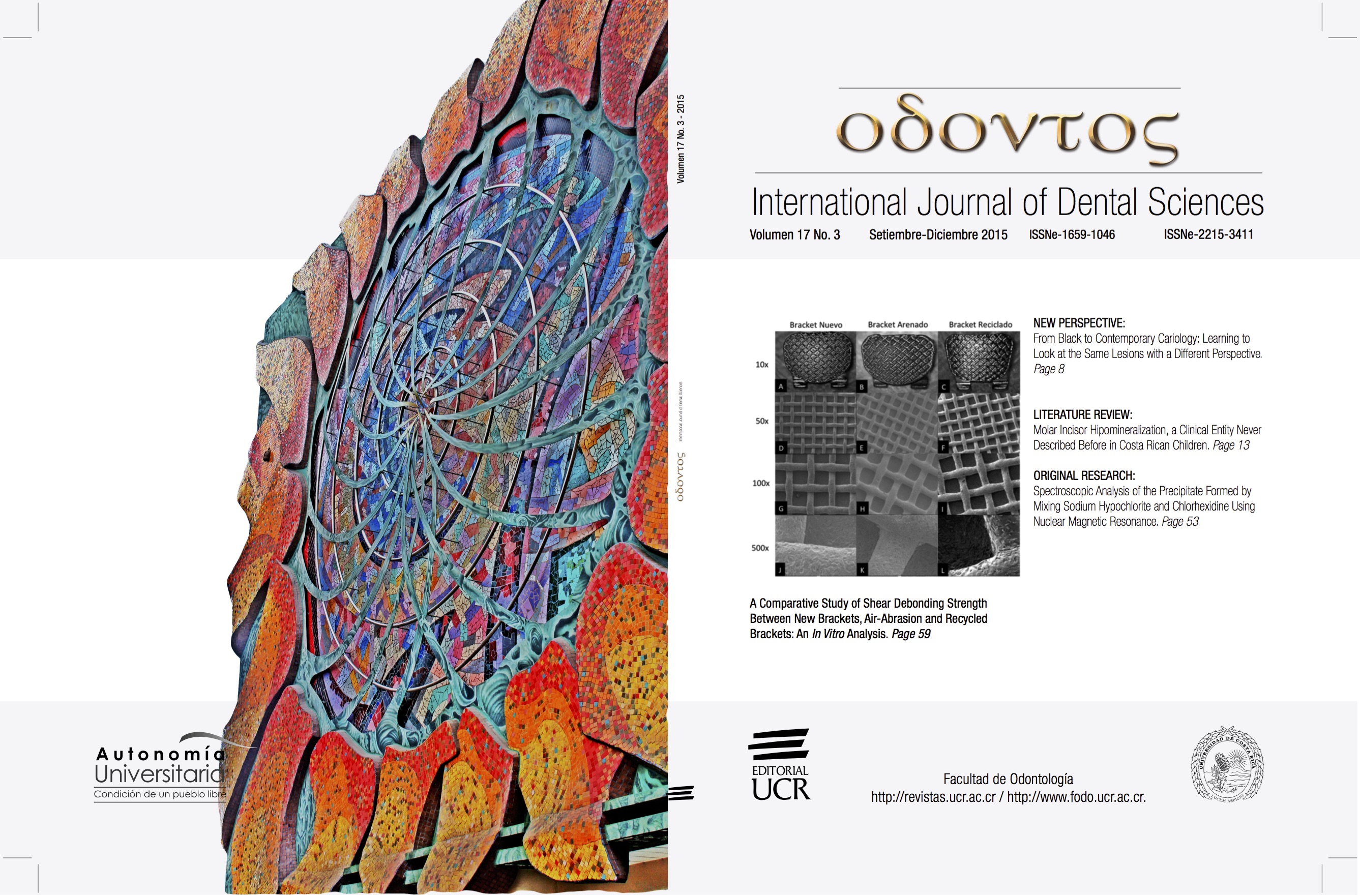Resumen
Amelogénesis imperfecta (AI) describe defectos en el esmalte derivados de mutaciones genéticas que se manifiestan en anormalidades estructurales en la dentición temporal y permanente. A pesar del amplio conocimiento que aumenta día tras día a nivel mundial sobre las mutaciones genéticas asociadas a la AI, existe poca investigación en su efecto sobre la calidad de vida de los pacientes. El objetivo de este estudio es determinar, en un cohorte de pacientes costarricenses afectados por esta patología, la percepción emocional sobre su calidad de vida que esta condición ha generado. Miembros de varias familias portadoras de AI se entrevistaron y sus experiencias sirvieron de base para desarrollar un instrumento (cuestionario), el cual se utilizó para evaluar el impacto de este padecimiento, en su calidad de vida. Se incluyeron 18 personas afectadas de AI, provenientes de 17 familias. Los resultados más relevantes revelaron que un 100 % de los participantes han sufrido burlas y rechazo; 77.8 % se mostraron preocupados por la herencia a sus hijos; 66.7 % les preocupa el costo del tratamiento; 89 % le atribuyen alta importancia a sus dientes, siendo no estadísticamente significativo por sexo (p = 0.732). El estudio indica que los profesionales en Odontología deben entender la AI no solo como un defecto en la estructura del esmalte dental, que demanda un manejo clínico especializado, sino como una condición que causa impacto negativo en la calidad de vida de quienes la padecen. Esto se debe considerar en la comunicación e interacción del profesional, los sujetos afectados y sus familiasCitas
Poulter JA , Murillo G, Brookes SJ, Smith CE, Parry DA, Silva S, Kirkham J, Inglehearn CF, Mighell AJ. Deletion of ameloblastin exon 6 is associated with amelogenesis imperfecta. Human Molecuar Genetics. 2014 Oct 15; 23(20):5317-24.
Bonilla A, Castro S. Amelogénesis Imperfecta. Revisión de literatura y reporte de un caso. Odontología Vital. 2001. 15, 24-29
Crawford P, Aldred M, Bloch-Zupan A. Amelogenesis imperfecta. Orphanet Journal of Rare Diseases. 2007; 2:17.
Varela M, Botella JM, García-Camba JM, García-Hoyos F. Amelogénesis Imperfecta: revisión. Cient Dent. 2008. 5(3); 239-246.
Wright JT, Carrion IA, Morris C. The molecular basis of hereditary enamel defects in humans. Journal of Dental Research. 2015; 94(1):52-61.
Murillo G, Silva S, Mata M, Esquivel MJ. Amelogénesis Imperfecta. Probabilidad genética de expresión en futuras generaciones de familias costarricenses. ODOVTOS. 2014; 16:71-86.
Gadhia K, McDonald S, Arkutu N, Malik K. Amelogenesis imperfecta: an introduction. British Dental Journal. 2013. 212(8); 377-379.
Kamala K, Guddad S. Amelogenesis Imperfecta, an overview. Dept. of Oral Medicine and Radiology. 2012. 5; 84-88.
Belmont C, López PM. Amelogénesis Imperfecta del tipo hipomaduración-hipoplasia con taurodontismo. Reporte de un caso. División de Estudios de Posgrado e Investigación. UNAM. 1998. 2(8); 18-22.
Aldred MJ, Crawford PJM, Savarirayan R. Amelogenesis Imperfecta – a classification and catalogue for the 21st century. Oral Dis. 2003; 9:19–23.
Coffield KD, Phillips C, Brady M, Roberts MW, Strauss RP, Wright JT. The psychosocial impact of developmental dental defects in people with hereditary amelogenesis imperfecta. American Dental Association. 2005 May; 136(5):620-630.
Organización Mundial de la Salud. Formulación de estrategias con el fin de alcanzar la salud para todos en el año 2000. Ginebra: OMS; 1994.
Mercado F, Hernández E. Las enfermedades crónicas desde la mirada de los enfermos y los profesionales de la salud: un estudio cualitativo en México. Cad. Saúde Pública, Rio de Janeiro. 2007. 23(9); 2178-2186.
Vasermanas D. La salud psicológica en las enfermedades crónicas, las repercusiones del estrés. Trabajo presentado en I Jornadas sobre la enfermedad de Behçet. Madrid, España: Asociación española de la enfermedad de Behçet. 2007.
Gil-Roales J. Psicología de la salud: aproximación histórica conceptual y aplicaciones. Madrid: Pirámide. 2004.
Vinaccia S, Orozco L. Aspectos psicosociales asociados con la calidad de vida de personas con enfermedades crónicas. Diversitas. 2005. 1(2); 125-137.
Pelechano V. Calidad de vida, familia y afrontamiento en la enfermedad física crónica: Datos y sugerencias para un modelo. J. Buendia, Familia y Psicología de la Salud. Madrid: Pirámide. 1999.
Parekh S, Almehateb M, Cunningham S. How do children with amelogénesis imperfecta feel about their teeth?. International Journal of Paediatric Dentistry. 2014. 24(5); 326-335.
Abanto J, Imparato J, Guedes-Pinto A, Bönecke M. Anomalías dentarias de impacto estético en odontopediatría: características y tratamiento. Rev Estomatol Herediana. 2012. 22(3); 171-8.
Sneller J, Buchanan H, Parekh S. The impact of amelogénesis imperfecta and support needs of adolescents with AI and their parents: an exploratory study. International Journal of Pediatric Dentistry. 2014. 24(6); 409-416.
Welbury R, Shaw L. A simple technique for removal of mottling, opacities and pigmentation from enamel. Dent Update 1990; 17: 161–163.
Montalvo A, Cabrera B, Quiñones S. Enfermedad crónica y sufrimiento: revisión de literatura. Aquichan. 2012. 12(2); 134-143.
Craig SA, Baker SR, Rodd HD. How do children view other children who have visible enamel defects?. International Journal of Paediatric Dentistry. 2015; 25(6):399-408.
Gómez B. Terapia cognitiva para trastornos psicológicos asociados a enfermedades físicas crónicas. España: Fundación AIGLE. 2011.
Iglesias JL. El adolescente como enfermo crónico. Enfermedad crónica en el adolescente. Pediatría Integral. Programa de Formación Continuada en Pediatría Extrahospitalaria. 2008. 19-22.
Rodríguez D, Acosta MG, Pierdoménico B, Tortolero MB. La amelogénesis imperfecta tratada por un equipo multidisciplinario. Oral Revista. 2010; 11(33):569-572.
Montero J, Bravo M, Albaladejo A, Hernández LA, Rosel EM. Validation the Oral Impact Profile (OHIP-14sp) for adults in Spain. Med Oral Patol Oral Cir Bucal. 2009; 14(1):44-50.
Stokes E, Ashcroft A. Plat MJ. Determining Liverpool adolescents' beliefs and attitudes in relation to oral health. Health Educ Res. 2006; 21(2):192-205.
Calero JA, Soto L. Amelogénesis Imperfecta. Informe de tres casos en una familia en Cali, Colombia. Colombia Med. 2005. 36(4); 47-50.
Vivek R, Singh A, Singh RK, Soni R, Chaturvedi TP. Amelogenesis imperfecta - Functional and esthetic rehabilitation of a mutilated dentition. Indian Journal of Dentistry. 2013; 4(1):60-65.

